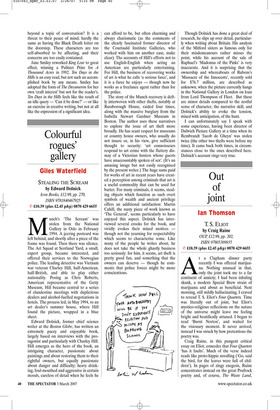Colourful rogues’ gallery
Giles Waterfield
STEALING THE SCREAM by Edward Dolnick Icon Books, £12.99, pp. 270, ISBN 9781840467925 ✆ £10.39 (plus £2.45 p&p) 0870 429 6655 Munch’s ‘The Scream’ was stolen from the National Gallery in Oslo in February 1994. A jeering postcard was left behind, and shortly after a piece of the frame was found. Then there was silence. The Art Squad at Scotland Yard, a small, expert group, became interested, and offered their services to the Norwegian police. The leading detective was Vietnam war veteran Charley Hill, half-American, half-British, and able to play either nationality. Posing as Chris Roberts, American representative of the Getty Museum, Hill became central to a series of clandestine meetings with duplicitous dealers and alcohol-fuelled negotiations in hotels. The process led, in May 1994, to an art dealer’s summer house, where Hill found the picture, wrapped in a blue sheet.
Edward Dolnick, former chief science writer at the Boston Globe, has written an extremely pacey and enjoyable book, largely based on interviews with the protagonist and particularly with Charley Hill. Hill emerges as the hero of the book, an intriguing character, passionate about paintings and about restoring them to their rightful owners, but equally passionate about danger and difficulty; heavy drinking, foul-mouthed and aggressive in certain moods, careless of detail when he feels he can afford to be, but often charming and always charismatic (as the comments of the clearly fascinated former director of the Courtauld Institute Galleries, who worked with him on another case, make clear). The accounts of Hill’s efforts not to use English-English when acting an American are particularly entertaining. For Hill, the business of recovering works of art is what he calls ‘a serious farce’, and it is a farce he enjoys — though now he works as a freelance agent rather than for the police.
The story of the Munch recovery is deftly interwoven with other thefts, notably at Russborough House, raided four times, along with the massive burglary from the Isabella Stewart Gardner Museum in Boston. The author uses these narratives to explore the issue of art theft more broadly. He has scant respect for museums or country house owners, who usually do not insure or, in his view, give sufficient thought to security: ‘art connoisseurs respond to art crime with the fluttery dismay of a Victorian hostess whose guests have unaccountably spoken of sex’. (It’s an amusing image but not easily recognised by the present writer.) The huge sums paid for works of art in recent years have created a perception among criminals that art is a useful commodity that can be used for barter. For many criminals, it seems, stealing objects which function as such overt symbols of wealth and ancient privilege offers an additional satisfaction: Martin Cahill, the nasty piece of work known as ‘The General’, seems particularly to have enjoyed this aspect. Dolnick has interviewed several crooks for the book, and vividly evokes their mixed motives though not the yearning for respectability which seems to characterise some. Like many of the people he writes about, he does not take the whole ghastly business too seriously: for him, it seems, art theft is pretty good fun, and something that the owners can deserve — though he comments that police forces might be more conscientious. Though Dolnick has done a great deal of research, he slips up over detail, particularly when writing about Britain. His analysis of the Mitford sisters as famous only for their misdemeanours rather misses the point, while his account of the sale of Raphael’s ‘Madonna of the Pinks’ is very inaccurate. And it is surprising that the ownership and whereabouts of Rubens’s ‘Massacre of the Innocents’, recently sold for $76.7 million, are described as unknown, when the picture currently hangs in the National Gallery in London on loan from Lord Thompson of Fleet. But these are minor details compared to the zestful sense of character, the narrative skill, and Dolnick’s ability to evoke the tension, mixed with anticipation, of the hunt.
I can unfortunately say I speak with some experience, having been director of Dulwich Picture Gallery at a time when its Rembrandt ‘Jacob de Gheyn’ was stolen twice (the other two thefts were before my time). It came back both times, in circumstances close to the ones described here. Dolnick’s account rings very true.










































































 Previous page
Previous page